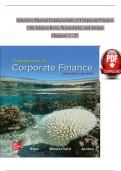Solutions Manual Fundamentals of Corporate Finance
13th Edition Ross, Westerfield, and Jordan
Chapters 1 - 27
,CHAPTERF1:FIntroductionFtoFCorporateFFinance
CHAPTERF2:FFinancialFStatements,FTaxes,FAndFCashFFlow
CHAPTERF3:FWorkingFwithFFinancialFStatements
CHAPTERF4:FLong-TermFFinancialFPlanningFandFGrowth
CHAPTERF5:FIntroductionFtoFValuation:FTheFTimeFValueFofFMoney
CHAPTERF6:FDiscountedFCashFFlowFValuation
CHAPTERF7:FInterestFRatesFandFBondFValuation
CHAPTERF8:FStockFValuation
CHAPTERF9:FNetFPresentFValueFandFOtherFInvestmentFCriteria
CHAPTERF10:FMakingFCapitalFInvestmentFDecisions
CHAPTERF11:FProjectFAnalysisFandFEvaluation
CHAPTERF12:FSomeFLessonsFfromFCapitalFMarketFHistory
CHAPTERF13:FReturn,FRisk,FAndFtheFSecurityFMarketFLine
CHAPTERF14:FCostFofFCapital
CHAPTERF15:FRaisingFCapital
CHAPTERF16:FFinancialFLeverageFandFCapitalFStructureFPolicy
CHAPTERF17:FDividendsFandFPayoutFPolicy
CHAPTERF18:FShort-TermFFinanceFandFPlanning
CHAPTERF19:FCashFandFLiquidityFManagement
CHAPTERF20:FCreditFandFInventoryFManagement
CHAPTERF21:FInternationalFCorporateFFinance
CHAPTERF22:FBehavioralFFinance:FImplicationsFforFFinancialFManage
CHAPTERF23:FEnterpriseFRiskFManagement
CHAPTERF24:OptionsFandFCorporateFFinance
CHAPTERF25:FOptionFValuation
CHAPTERF26:FMergersFandFAcquisitions
CHAPTERF27:FLeasing
,CHAPTER 1 F
INTRODUCTION TO CORPORATE F F F
FINANCE
AnswersFtoFConceptsFReviewFandFCriticalFThinkingFQuestions
1. CapitalFbudgetingF(decidingFwhetherFtoFexpandFaFmanufacturingFplant),FcapitalFstructureF(decidingFw
hetherFtoFissueFnewFequityFandFuseFtheFproceedsFtoFretireFoutstandingFdebt),FandFworkingFcapitalFmana
gementF(modifyingFtheFfirm’sFcreditFcollectionFpolicyFwithFitsFcustomers).
2. Disadvantages:FunlimitedFliability,FlimitedFlife,FdifficultyFinFtransferringFownership,FhardFtoFraiseFcapi
talFfunds.FSomeFadvantages:Fsimpler,FlessFregulation,FtheFownersFareFalsoFtheFmanagers,FsometimesFp
ersonalFtaxFratesFareFbetterFthanFcorporateFtaxFrates.
3. TheFprimaryFdisadvantageFofFtheFcorporateFformFisFtheFdoubleFtaxationFtoFshareholdersFofFdistributedF
earningsFandFdividends.FSomeFadvantagesFinclude:FlimitedFliability,FeaseFofFtransferability,FabilityFtoFr
aiseFcapital,FunlimitedFlife,FandFsoFforth.
4. InFresponseFtoFSarbanes-
Oxley,FsmallFfirmsFhaveFelectedFtoFgoFdarkFbecauseFofFtheFcostsFofFcompliance.FTheFcostsFtoFcomplyF
withFSarboxFcanFbeFseveralFmillionFdollars,FwhichFcanFbeFaFlargeFpercentageF ofF aF smallF firmsF profits.
F AF majorF costF ofF goingF darkF isF lessF accessF toF capital.F SinceF theF
firmFisFnoFlongerFpubliclyFtraded,FitF
canFnoFlongerFraiseFmoneyFinFtheFpublicFmarket.FAlthoughFtheFcompanyFwillFstillFhaveFaccessFtoFbankF
loansFandFtheFprivateFequityFmarket,FtheFcostsFassociatedFwithFraisingFfundsFinFtheseFmarketsFareFusual
lyFhigherFthanFtheFcostsFofFraisingFfundsFinFtheFpublicFmarket.
5. TheF treasurer’sF officeF andF theF controller’sF officeF areF theF twoF primaryF organizationalF groupsF thatF
reportFdirectlyFtoFtheFchiefFfinancialFofficer.FTheFcontroller’sFofficeFhandlesFcostFandFfinancialFaccount
ing,FtaxFmanagement,FandFmanagementFinformationFsystems,FwhileFtheFtreasurer’sFofficeFisFresponsib
leF forF cashF andF creditF management,F capitalF budgeting,F andF financialF planning.F Therefore,FtheFstudyF
ofFcorporateFfinanceFisFconcentratedFwithinFtheFtreasuryFgroup’sFfunctions.
6. ToFmaximizeFtheFcurrentFmarketFvalueF(shareFprice)FofFtheFequityFofFtheFfirmF(whetherFit’sFpublicly-
FtradedForFnot).
7. InFtheFcorporateFformFofFownership,FtheFshareholdersFareFtheFownersFofFtheFfirm.FTheFshareholdersFele
ctFtheFdirectorsFofFtheFcorporation,FwhoFinFturnFappointFtheFfirm’sFmanagement.FThisFseparationFofFow
nershipFfromFcontrolFinFtheFcorporateFformFofForganizationFisFwhatFcausesFagencyFproblemsFtoFexist.F
ManagementFmayFactFinFitsFownForFsomeoneFelse’sFbestFinterests,FratherFthanFthoseFofFtheFshareholder
s.FIfFsuchFeventsFoccur,FtheyFmayFcontradictFtheFgoalFofFmaximizingFtheFshareFpriceFofFtheFequityFofFth
eFfirm.
8. AFprimaryFmarketFtransaction.
, B-2F SOLUTIONS
9. InFauctionFmarketsFlikeFtheFNYSE,FbrokersFandFagentsFmeetFatFaFphysicalFlocationF(theFexchange)FtoF
matchFbuyersFandFsellersFofFassets.FDealerFmarketsFlikeFNASDAQFconsistFofFdealersFoperatingFatFdisp
ersedFlocalesFwhoFbuyFandFsellFassetsFthemselves,FcommunicatingFwithFotherFdealersFeitherFelectronic
allyForFliterallyFover-the-counter.
10. SuchForganizationsFfrequentlyFpursueFsocialForFpoliticalFmissions,FsoFmanyFdifferentFgoalsFareFconcei
vable.FOneFgoalFthatFisFoftenFcitedFisFrevenueFminimization;Fi.e.,FprovideFwhateverFgoodsFandFservices
FareFofferedFatFtheFlowestFpossibleFcostFtoFsociety.FAFbetterFapproachFmightFbeFtoFobserveFthatFevenFaF
not-for-
profitFbusinessFhasFequity.FThus,FoneFanswerFisFthatFtheFappropriateFgoalFisF toFmaximizeFtheFvalueFofF
theFequity.
11. Presumably,FtheFcurrentFstockFvalueFreflectsFtheFrisk,Ftiming,FandFmagnitudeFofFallFfutureFcashFflows,F
bothFshort-termFandFlong-term.FIfFthisFisFcorrect,FthenFtheFstatementFisFfalse.
12. AnFargumentFcanFbeFmadeFeitherFway.FAtFtheFoneFextreme,FweFcouldFargueFthatFinFaFmarketFeconomy,F
allFofFtheseFthingsFareFpriced.FThereFisFthusFanFoptimalFlevelFof,FforFexample,FethicalFand/orFillegalFbeh
avior,FandFtheFframeworkFofFstockFvaluationFexplicitlyFincludesFthese.FAtFtheFotherFextreme,FweFcould
FargueFthatFtheseFareFnon-
economicFphenomenaFandFareFbestFhandledFthroughFtheFpoliticalFprocess.FAFclassicF(andFhighlyFreleva
nt)FthoughtFquestionFthatFillustratesFthisFdebateFgoesFsomethingFlikeFthis:F“AFfirmFhasFestimatedFthatFt
heFcostFofFimprovingFtheFsafetyFofFoneFofFitsFproductsFisF$30Fmillion.FHowever,FtheFfirmFbelievesFthatF
improvingFtheFsafetyFofFtheFproductFwillFonlyFsaveF$20FmillionFinFproductFliabilityFclaims.FWhatFshoul
dFtheFfirmFdo?”
13. TheFgoalFwillFbeFtheFsame,FbutFtheFbestFcourseFofFactionFtowardFthatFgoalFmayFbeFdifferentFbecauseFofF
differingFsocial,Fpolitical,FandFeconomicFinstitutions.
14. TheFgoalFofFmanagementFshouldFbeFtoFmaximizeFtheFshareFpriceFforFtheFcurrentFshareholders.FIfFmana
gementFbelievesFthatFitFcanFimproveFtheFprofitabilityFofFtheFfirmFsoFthatFtheFshareFpriceFwillFexceedF$3
5,FthenFtheyFshouldFfightFtheFofferFfromFtheFoutsideFcompany.FIfFmanagementFbelievesFthatFthisFbidder
ForFotherFunidentifiedFbiddersFwillFactuallyFpayFmoreFthanF$35FperFshareFtoFacquireFtheFcompany,Fthen
FtheyFshouldFstillFfightFtheFoffer.FHowever,FifFtheFcurrentFmanagementFcannotFincreaseFtheFvalueFofFthe
FfirmFbeyondFtheFbidFprice,FandFnoFotherFhigherFbidsFcomeFin,FthenFmanagementFisFnotFactingFinFtheFin
terestsFofFtheFshareholdersFbyFfightingFtheFoffer.FSinceFcurrentFmanagersFoftenFloseFtheirFjobsFwhenFth
eFcorporationFisFacquired,FpoorlyFmonitoredFmanagersFhaveFanFincentiveFtoFfightFcorporateFtakeoversFi
nFsituationsFsuchFasFthis.
15. WeFwouldFexpectFagencyFproblemsFtoFbeFlessFsevereFinFotherFcountries,FprimarilyFdueFtoFtheFrelatively
smallFpercentageFofFindividualFownership.FFewerFindividualFownersFshouldFreduceFtheFnumberFofFdiv
F
erseFopinionsFconcerningFcorporateFgoals.FTheFhighFpercentageFofFinstitutionalFownershipFmightFleadF
toFaFhigherFdegreeFofFagreementFbetweenFownersFandFmanagersFonFdecisionsFconcerningFriskyFproject
s.FInFaddition,FinstitutionsFmayFbeFbetterFableFtoFimplementFeffectiveFmonitoringFmechanismsFonFman
agersFthanFcanFindividualFowners,FbasedFonFtheFinstitutions’FdeeperFresourcesFandFexperiencesFwithFth
eirFownFmanagement.FTheFincreaseFinFinstitutionalFownershipFofFstockFinFtheFUnitedFStatesFandFtheFgro
wingFactivismFofFtheseFlargeFshareholderFgroupsFmayFleadFtoFaFreductionFinFagencyFproblemsFforFU.S.
FcorporationsFandFaFmoreFefficientFmarketFforFcorporateFcontrol.




